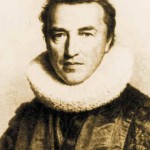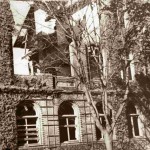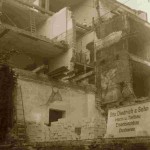Our school, the “Amandus-Abendroth-Gymnasium”, was established in 1810 by senator and burgomaster Amandus Augustus Abendroth. Later he became the eponym of the school. When Abendroth was bailiff in Cuxhaven the small town had many problems as far as business and industry was concerned.
Many people thought that Abendroth was the right person to erect the town.
Amandus Abendroth weighed to be a very active and miscellaneous person.
Due to Amandus Abendroth, Cuxhaven envolved into a more forward-looking town. Schools and a swimming bath were opened up furthermore a church was constructed. One of the schools was the so called “Rektorschule” (contemporary AAG), a school which was merely for boys, but there was also the so called “Töchterschule” for girls.
Abendroth’s aim was to teach young people how to exist in society and not only to teach mathematics, languages or writing. Nevertheless the accumulation at the school was taken very serious. Languages like English and French, which were very modern at that time were tought at the “Rektorschule”. English was very important for the people who lived here close to the harbour where many people from different countries arrived.
- January 20th 1818, „40 Ld’or“, a trust, bestowed the first school library on the school. Achieving money the teachers and clerks immediately began to arrange a library.
- 1821 Amandus Abendroth relocated to Hamburg which is a large town about 2 hours away from here (by car). Anyhow Abendroth got still involved with school affairs. He wrote letters to Cuxhaven and made enquiries about how the school and the town emerge.
- 1847 to 1851 Contrary to Abendroth’s plans the teachers began to teach Latin.
- 1852 Cuxhaven was separated into small communes. The number of inhabitants was 3931. Therefore the number of pupils was fairish small. Only about 20 young people went to school.
- March 31th1882: After about 70 years after the foundation of the school the curriculum was accepted.
- 1887: Discussions about the future of the school began.
- 1889: The „Rektorschule“ became a „Higher School“.
- April 1st 1891: foundation of the so called „Staatliche Höhere Bürgerschule mit Latein-Abteilungen zu Cuxhaven”.
- May 1st 1891: Opening ceremony of the “National Secondary Modern School” (Staatliche Höhere Bürgerschule mit Latein-Abteilungen), the headmaster was Prof. Dr. D. Rohde.
- 1893: The school had its first “Abitur”-year (Abitur (German) =diploma from German secondary school qualifying for university admission or matriculation).
- In the following decades the population of Cuxhaven continuously increased, so the building had to be extended several times because of the increasing number of students.
- In August 1895, a new school building, built on the place where the current AAG-building can still be found, was finished and opened, but unfortunately, it was nearly completely destroyed in World War II, so the stones having been used at the end of the 19th century are, except a few ones, not the stones of which the current building consists of. This building was also enlarged (1904).
- In 1898, the school got the status of a “Higher National School” (German: Höhere Staatsschule). According to this, the school was named “Höhere Staatsschule in Cuxhaven, Gymnasium und Realschule” and later renamed to “Amandus-Abendroth-Gymnasium”.
- The school year 1912/1913 has a key role in the school’s history: Girls were admitted for the first time. In the Easter term 1912 four girls had the honor to be the first ones.
- In August 1914, World War I began, which of course influenced the everyday life at school: Many students from Cuxhaven volunteered for going to war and had to take their exams in advance. Eleven teachers were drawn to military service or also went to war voluntarily, so the daily work at school was unhinged. The education could just be kept up by “help-teachers”. When World War I had finished in 1918, boards with the names of the dead soldiers, 112 students and 8 teachers, were hung up at the wall of the assembly hall. Those boards can still be found there.
- 1937: Cuxhaven gets Prussian – AAG is now influenced by styles from Hamburg.
- 1937/38: The school is renamed “Staatliche Oberschule für Jungen in Cuxhaven”.
- 1943: During WW II boys and young adults from AAG are drawn to military to supply the military-service. The final secondary-school examinations are abolished until 1945.
- April 14th 1945: A bombing raid upsets our school, which mainly destroys the auditorium and the gymnasium.
- 1946: The assembly hall is sold to the “Lichtbühne GmbH” who rebuild the auditorium within one year.
- Easter 1946: A new school year starts for the first time after World War II.
- 1948: The daily school life gets back to normal everyday life.
- 1949: The giant hole caused by the bombing raid is filled up again.
- 1951: For the first time our school gets teachers on probation.
- 1958: The memorial tablet for all victims of WW II is put up in the assembly hall.
- 1966: For the first time two graduation years are at our school at the same time. The beginning of a schoolyear is switching from spring to summer.
- 1976/77: The upper stage gets “Sekundarstufe II” and from now on sixth formers have tutors and terms instead of classes and class teachers. At the same time the cooperation with the neighbor-school “Lichtenberg-Gymnasium” starts.
- Until 1980: A lot of building measures, more students, more teachers and advancements.
- 1980: The naming of the classes 5 to 11 switches to 7 to 13.
- 2003: The “Orientierungsstufe” is cancelled, the younger students at the age of 11 and 12 and their classes five and six are going to AAG now.
- 2006: The first graduation year takes their final exam “Zentralabitur” which means that pupils all over Niedersachsen take the same exams at the same time.
- June 2010: Mrs. Kueppers’ English class works on a project: An English website of the school. ;-)




